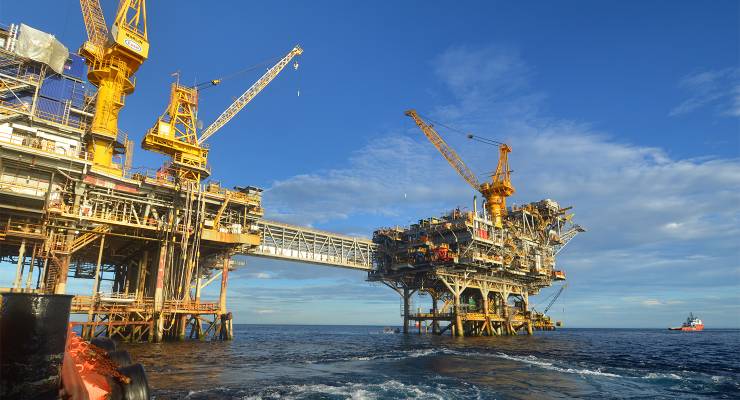
Labor has faced pressure from all directions this year regarding offshore fossil fuel projects. The government appeared to sneak through legislation that makes it easier for these projects to get around environmental regulation, before bowing to internal lobbying and reinstating Environment Minister Tanya Plibersek’s ability to veto projects. Beyond that, the question remains: what happens to the project infrastructure if and when we finally phase out fossil fuels?
The Institute for Energy Economics and Financial Analysis identified more than 1,000 wells and 57 fixed facilities offshore that are nearing their end, resulting in what industry body the Centre of Decommissioning Australia estimates will be 5.7 million tonnes of material to be dealt with. The National Offshore Petroleum Safety and Environmental Management Authority (NOPSEMA) says the process will be “complex, expensive, span many years and introduce many new and significant safety, environmental and well integrity risks”. The costs are eye-watering: $60 billion, as estimated in late 2023 by the Department of Industry, Science and Resources.
Where is all this stuff?
As this map shows, there are rigs all over Australian waters, with the greatest concentrations off the coast of Western Australia and in the Bass Strait between Victoria and Tasmania.
This is a global issue — more than 70% of the world’s oil and gas production uses ageing infrastructure, exploiting fields that are, as the Lowy Institute puts it, “rapidly approaching their economic limit”. The Commonwealth Secretariat, in an early 2023 study, estimated more than 50,000 offshore wells will be decommissioned worldwide by 2040.
Lack of expertise
It tells its own story that in 2023 Australia’s Industry Department was still putting together documents with names like “Roadmap to establish an Australian decommissioning industry” — the infrastructure is old and decrepit, but the industry for dealing with it is in its infancy. Shareholder advocacy group the Australasian Centre for Corporate Responsibility (ACCR) put out a 2023 report on decommissioning that identifies Australia’s inexperience, involving the wide variation of “operator preparedness”, as one of the primary risks.
Again, this is an international issue — as the Commonwealth Secretariat put it in its 2023 analysis: “Relative to other oil and gas activities, decommissioning is at an infancy stage with limited country and company experience. Decommissioning carries significant environmental and safety risks which should be factored across the entirety of a project’s life cycle.”
This makes the true extent of the costs of decommissioning hard to predict. The ACCR’s report cited analysis of selected offshore oil and gas platform decommissioning projects in the North Sea that found the average actual cost was about 76% greater than had been estimated.
Toxic reefs?
Companies such as ExxonMobil and Woodside are trying to leave great chunks of these partially dismantled platforms in the sea as “artificial reefs”. These remains contain mercury, lead, hydrocarbons and naturally occurring radioactive materials (known by the slightly misleading acronym NORM), rendering the sea life “too dangerous to consume”, according to Friends of the Earth Offshore Fossil Gas campaigner Jeff Waters.
Diplomatic tensions
If you were looking for a synecdoche of all the problems associated with decommissioning, look no further than the Northern Endeavour. The rust-covered oil rig has already cost taxpayers hundreds of millions of dollars and could cost up to a billion to be packed up and towed away for scrap.
Now redundant, the Northern Endeavour was run by Woodside until 2016, at which point it was sold to a small, inexperienced company called North Oil and Gas Australia (NOGA). By 2019, after a series of environmental and work safety notices from NOPSEMA, the rig was forced to shut down. The decision to sell to NOGA, a company that could not afford to decommission the ageing facility, was slammed by everyone from Greenpeace to Chevron. NOGA went into liquidation and the government is now on the hook to finish the job.
So there’s that, but it’s also the most prominent example of the other risk of offshore rigs: international relations. The Northern Endeavour is subject to a bizarre set of contradictory rules; it sits above Australia’s continental shelf for the purposes of extraction, but floats on Indonesia’s waters.
“[Northern Endeavour] falls into this very unique situation where Australia is regulating the decommissioning of this facility operating on the Australian seabed, but the marine environment and the greatest interest in terms of the marine environment is Indonesian rather than Australia,” Donald Rothwell, Australian National University professor of international law, told Crikey.
“So, Australia needs to be very sensitive to the fact that in any decommissioning, the environmental impact is not such that could trigger any concerns on the part of Indonesia.”
And it gets weirder — the Perth Treaty, which sets out the nations’ exclusive economic zones and was signed by both nations in 1997, has never been ratified by Indonesia.
“And so that creates an additional sensitivity from Australia’s side in terms of ensuring that a higher this completely by the book and ensure the very highest environmental standards otherwise,” Rothwell said.
If there are any stuff-ups, Indonesia could potentially pursue compensation for environmental damage, and would likely rekindle Indonesia’s intermittent calls to revisit the Perth Treaty (which Indonesia has thus far been observing despite it having no legal force), which are heavily skewed towards Australia in the current breakdown.
Adding to this, Rothwell remarked, is the coming change of leadership in Indonesia: “Could a new Indonesian government seek to revisit these issues? I think that’s a valid question to ask.”
Indeed, with dozens of ageing rigs around Australia creakily shuffling towards expiry, it’s one of many valid questions.








Cannot believe that Woodside can sell the Norther Endeavour to another entity and then suddently the massive decommissioning cost is owned by the taxpayer. I seriously do not believe. This is where draconian legislation is in order. Thanks for the heads up.
Dream on, Bob. Legislation will surely become ever more draconian, but only for people waking up to the fact that everything has been poisoned for corporate profits. Anyone who watches which way the wind blows can guess how this utter shemozzle will be ‘managed’.
This might be a good opportunity for a bit of Crikey research. How many aging and environmentally unsustainable mines/rigs/fossil fuel constructs have been conveniently sold by large companies to smaller ones, only to suddenly close down and the new buyer go broke? Suprise, either the taxpayer has to pay for the thing to be decommissioned, or the mine/rig/etc simply stays where it is, unwanted by all and ignored by the media while tailings leach into waterways and toxic dust blows into communities. Is it just me, or can anyone else smell a rat in these dealings?
Yes, the rat nest of utterly captured “government”.
Thanks Charlie. Another hugely informative article which raises some huge questions.
I’m always infuriated at the way so many of “our” old mines are left to rot in the open, despite governments saying they must be remediated by owners who suddenly go bust before any work of remediation begins or leave it half done for eternity.
But this is particularly shocking for the damage being done to marine environment, which I’ve often wondered about.
Surely, the decommissioning of these large rigs is at the forefront of government discussion prior to their allowance to be actually commissioned?
Or doesn’t anybody bother worrying about what may happen in the future?
Absolutely shocking, or maybe I’m just naive to think that our government is any better than others.
Agree with you Marcia. Perhaps our governments should ask for bonds before the rigs/mines are commissioned to offset the cost of decomissioning.
As I understand it, there are bonds – but they’re in the range of the the spare change found down the back of the couch in the staff tea room, so just a minor operating expense.
Also Australians are to blame with their lax attitudes and low info comfort zone by following RW MSM and acquiring political talking points or wedges.
One notices, including amongst many rusted on and ageing ALP voters in regions, is that climate science is BS, renewables, EVs, solar etc. don’t work or cannot replace fossil fuels; two decades of RW fossil fuel agitprop does the job.
A consistent talking point has been how solar panels will create an environmental crisis, in addition to warming up the atmosphere, because they cannot be disposed of and/or recycled; too easy…..
Worse, so easy to rebut and counter yet nobody seems able nor interested?
$60 billion is a lot of money and the fossil fuel vandals will definitely want to avoid that expense. Fortunately for them they can buy every australian politician less than a million each. They will then agree, by a stratagem yet to be worked out, that the good old Aussie taxpayer will see them right. We are about to get diddled again.
Removal will be outsourced to a US company at great cost with zero remediation. A bit like the Brits cleaning up atom bomb sites in Aus.
If rigs need to be shut down, leaving the submarine structure in place as an artificial reef is the best possible thing to do since it creates habitat.
That the marine life of such reefs might be so contaminated that it can’t be harvested for human consumption is a bonus – being inedible by humans is the best possible protection; I understand Chernobyl was a haven for wildlife at least until Russia attacked.
Nice silver lining identification there.
The dominance of humans really does need to be subject to rapid de-emphasis if any remaining biodiversity is to persist; we (or rather, the ruling class, whose meat puppets we all are), are the one true vermin.
Wow. I think taking responsibility not just the profit and being forced to clean it up would be a better option than leaving it David don’t you. It reminds me of James Hardie.
If they have to clean it up then they clean it up in place so as to leave behind a haven for marine wildlife.
And yet fossil fools pretend that disposing of used solar panels and wind turbines is an insuperable problem.
Great minds think alike, said same above 🙂